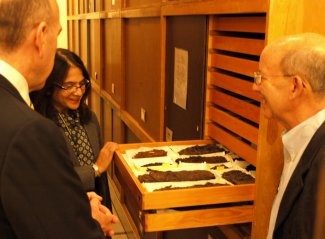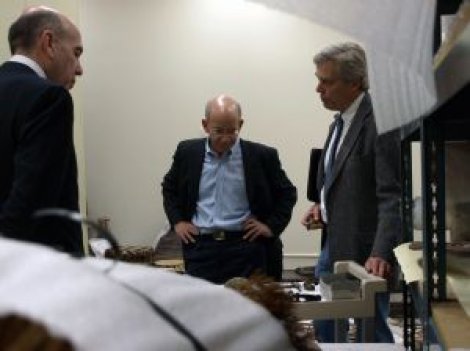By Melody Ward Leslie
Development Communications
Rest easy, Oregonians — your ancient treasures are safe and secure in the new collections center at the University of Oregon Museum of Natural and Cultural History.
What's more, you will be able to see many of them when the museum's old vault becomes an exhibition hall.

The $2.8 million wing solves a space crunch so severe that it saw many artifacts and fossils stashed temporarily in several World War II-era buildings around campus.
The law requires public agencies to protect and preserve such items, so funds for the long-needed addition included $2.2 million from the 2005 highway bill authorized at the request of U.S. Rep. Peter DeFazio (D-Ore.). Private gifts and grants covered the rest.
DeFazio and UO President Richard Lariviere had their first tour of the new facilities on Nov. 13 (2009). They test-drove the new compact storage units and checked the progress of a lengthy move so complex that Erlandson described it as something of a "shell game" due to the delicacy of many items.
"It's easier to turn than my Dodge Dart," DeFazio said, using one hand to make a floor-to-ceiling bank of cabinets holding 24,000 pounds glide to one side. The mobile storage system doubles the museum's storage capacity while making it possible to quickly retrieve items for research or display.
Lariviere said the tour reinforced for him the value of locating such extensive archaeological and ethnographic collections at the UO.
"As precious a charge as it is to preserve our history, we have to be able to explain it as well," he said. "It's the explanation that endows an artifact with its value, and this museum carries out this mission superbly."
In addition to a modern curation facility and state-of-the-art vaults, the wing features a public galleria, funded mainly by a grant from the Ford Family Foundation, which enables the museum to host larger community events and expand educational programs.
The Oregon Legislature established the state's natural history museum at the UO in 1935 to help keep artifacts and fossils found on Oregon's public lands from being exported to museums in other states or countries.
Public agencies call in UO archaeologists when highway and public works projects unearth sites such as the state's oldest known Chinatown, found under Jacksonville's main street during a transportation project in 2004.
The museum's research division also conducts field schools and grant-funded research across the state (and beyond), working closely with Oregon's Native American tribes — activities that also add to the growth of collections.
The collections center and new exhibit hall are part of a three-phase, $9.65 million project to create a unified museum complex. The last phase is a new wing to provide modern labs and facilities for museum researchers who do $2 million of work annually on transportation projects.
